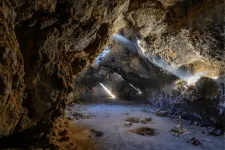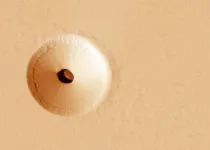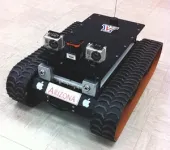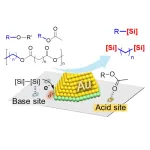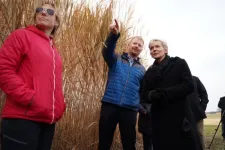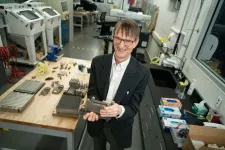(Press-News.org) House hunting on Mars could soon become a thing, and researchers at the University of Arizona are already in the business of scouting real estate that future astronauts could use as habitats. Researchers in the UArizona College of Engineering have developed technology that would allow a flock of robots to explore subsurface environments on other worlds.
"Lava tubes and caves would make perfect habitats for astronauts because you don't have to build a structure; you are shielded from harmful cosmic radiation, so all you need to do is make it pretty and cozy," said Wolfgang Fink, an associate professor of electrical and computer engineering at UArizona.
Fink is lead author of a new paper in Advances in Space Research that details a communication network that would link rovers, lake landers and even submersible vehicles through a so-called mesh topology network, allowing the machines to work together as a team, independently from human input. According to Fink and his co-authors, the approach could help address one of NASA's Space Technology Grand Challenges by helping overcome the limited ability of current technology to safely traverse environments on comets, asteroids, moons and planetary bodies. In a nod to the fairy tale "Hansel and Gretel," the researchers named their patent-pending concept the "Breadcrumb-Style Dynamically Deployed Communication Network" paradigm, or DDCN.
A fairy tale inspires the future
"If you remember the book, you know how Hansel and Gretel dropped breadcrumbs to make sure they'd find their way back," said Fink, founder and director of the Visual and Autonomous Exploration Systems Research Laboratory at Caltech and UArizona. "In our scenario, the 'breadcrumbs' are miniaturized sensors that piggyback on the rovers, which deploy the sensors as they traverse a cave or other subsurface environment."
Continuously monitoring their environment and maintaining awareness of where they are in space, the rovers proceed on their own, connected to each other via a wireless data connection, deploying communication nodes along the way. Once a rover senses the signal is fading but still within range, it drops a communication node, regardless of how much distance has actually passed since it placed the last node.
"One of the new aspects is what we call opportunistic deployment – the idea that you deploy the 'breadcrumbs' when you have to and not according to a previously planned schedule," Fink said.
All the while, there is no need for input from the mother rover; each subordinate rover will make that determination on its own, Fink added. The system can work in one of two ways, Fink explained. In one, the mother rover acts as a passive recipient, collecting data transmitted by the rovers doing the exploration. In the other, the mother rover acts as the orchestrator, controlling the rovers' moves like a puppet master.
Machines take over
The new concept dovetails with the tier-scalable reconnaissance paradigm devised by Fink and colleagues in the early 2000s. This idea envisions a team of robots operating at different command levels – for example, an orbiter controlling a blimp, which in turn controls one or more landers or rovers on the ground. Already, space missions have embraced this concept, several with participation by UArizona researchers. For example, on Mars, the Perseverance rover is commanding Ingenuity, a robotic helicopter. A concept for another mission, which ultimately was not selected for funding, proposed sending an orbiter carrying a balloon and a lake lander to study one of the hydrocarbon seas on Saturn's moon Titan. The breadcrumb approach takes the idea one step further by providing a robust platform allowing robotic explorers to operate underground or even submerged in liquid environments. Such swarms of individual, autonomous robots could also aid in search and rescue efforts in the wake of natural disasters on Earth, Fink said.
Fink said the biggest challenge, apart from getting the rovers inside the subsurface environment in the first place, is to retrieve the data they record underground and bring it back to the surface. The DDCN concept allows a team of rovers to navigate even convoluted underground environments without ever losing contact to their "mother rover" on the surface. Outfitted with a light detection and ranging system, or lidar, they could even map out cave passages in all three dimensions, not unlike the drones that can be seen exploring an alien spacecraft in the movie "Prometheus."
"Once deployed, our sensors automatically establish a nondirected mesh network, which means each node updates itself about each node around it," said Fink, who first detailed the DDCN concept in a proposal to NASA in 2019.
"They can switch between each other and compensate for dead spots and signal blackouts," added Mark Tarbell, paper co-author and senior research scientist in Fink's laboratory. "If some of them die, there still is connectivity through the remaining nodes, so the mother rover never loses connection to the farthest node in the network."
Mission of no return
The robust network of communication nodes ensures all the data collected by the robotic explorers make it back to the mother rover on the surface. Therefore, there is no need to retrieve the robots once they have done their job, said Fink, who published the idea of using groups of expendable mobile robotic surface probes as early as 2014.
"They're designed to be expendable," he said. "Instead of wasting resources to get them into the cave and back out, it makes more sense to have them go as far as they possibly can and leave them behind once they have fulfilled their mission, run out of power or succumbed to a hostile environment."
"The communication network approach introduced in this new paper has the potential to herald a new age of planetary and astrobiological discoveries," said Dirk Schulze-Makuch, president of the German Astrobiological Society and author of many publications on extraterrestrial life. "It finally allows us to explore Martian lava tube caves and the subsurface oceans of the icy moons – places where extraterrestrial life might be present."
The proposed concept "holds magic," according to Victor Baker, a UArizona Regents Professor of Hydrology and Atmospheric Sciences, Geosciences and Planetary Sciences. "The most amazing discoveries in science come about when advances in technology provide both first-time access to a thing or place and the means of communicating what is thereby discovered to creative minds that are seeking understanding," Baker said.
Exploring hidden ocean worlds
In places that call for submersible robots, the system could consist of a lander – either floating on a lake, as might be the case on Titan, or sitting on the ice atop a subsurface ocean like on Europa – that is connected to the submarine, for example through a long cable. Here the communication nodes would act as repeaters, boosting the signal in regular intervals to prevent it from degrading. Importantly, Fink pointed out, the nodes have the capabilities to gather data themselves – for example measuring pressure, salinity, temperature and other chemical and physical parameters – and to ingest the data into the cable connecting back to the lander.
"Imagine you make it all the way to Europa, you melt your way through miles of ice, make it down to the subsurface ocean, where you find yourself surrounded by alien life, but you have no way of getting data back to the surface," he said. "That's the scenario we need to avoid."
Having developed the rovers and the communication technology, Fink's group is now working on building the actual mechanism by which the rovers would deploy the communication nodes.
"Basically, we're going to teach our 'Hansels' and 'Gretels' how to drop the breadcrumbs so they add up to a functioning mesh communication network," Fink said.
END
Hansel and Gretel's breadcrumb trick inspires robotic exploration of caves on Mars and beyond
University of Arizona engineers have developed a system that allows autonomous vehicles to scout out underground habitats for astronauts.
2023-03-18
ELSE PRESS RELEASES FROM THIS DATE:
3D radar scan provides clues about threats to iconic Alaskan glacier
2023-03-18
A detailed "body scan" of Malaspina Glacier, one of Alaska's most iconic glaciers, revealed that its bulk lies below sea level and is undercut by channels that may allow ocean water to gain access, should its coastal barrier erode. This makes the glacier more vulnerable to seawater intrusion than previously thought and may cause it to retreat faster than predicted.
The findings, published by University of Arizona researchers in the Journal of Geophysical Research, underscore ...
Changes in mangrove blue carbon under elevated atmospheric CO2
2023-03-18
As one of the major blue carbon ecosystems, mangroves provide critical ecosystem services in mitigating global climate change. However, the future complex and variable climate conditions may lead to the uncertainty in trajectories of blue carbon capacity. Elevated atmospheric CO2 concentrations (eCO2) is projected to become a prominent driver to mangrove blue carbon in the future.
A group of scientists working on blue carbon reviewed studies on “changes in mangrove blue carbon under elevated atmospheric CO2” to identify the pathways for how eCO2 might influence mangrove ecosystem carbon cycling. The research is published as a review article in Ecosystem health and sustainability, ...
Study examines the link between mental health and oral health
2023-03-18
Alexandria, VA – A study examining the mental health-oral health association cross-sectionally and longitudinally was presented at the 52nd Annual Meeting & Exhibition of the AADOCR, held in conjunction with the 47th Annual Meeting of the CADR. The AADOCR/CADR Annual Meeting & Exhibition took place at the Oregon Convention Center in Portland on March 15-18, 2023.
The study, led by Alex Kalaigian of the University of California, San Francisco School of Dentistry, acquired self-reported data from the Population ...
New catalyst helps turn plastic waste into useful organosilane compounds
2023-03-18
Tokyo, Japan – Researchers from Tokyo Metropolitan University have found that gold nanoparticles supported on a zirconium oxide surface help turn waste materials like biomass and polyester into organosilane compounds, valuable chemicals used in a wide range of applications. The new protocol leverages the cooperation between gold nanoparticles and the amphoteric (both acid and base) nature of the zirconium oxide support. The result is a reaction that requires less demanding conditions, a greener method for upcycling waste.
Recycling is a big part of humanity’s solution to the global issue of plastic waste. Much ...
DOE funds next-generation Center for Bioenergy Innovation to advance renewable jet fuel
2023-03-17
The Center for Bioenergy Innovation has been renewed by the Department of Energy as one of four bioenergy research centers across the nation to advance robust, economical production of plant-based fuels and chemicals. CBI, led by Oak Ridge National Laboratory, is focused on the development of nonfood biomass crops and specialty processes for the production of sustainable jet fuel to help decarbonize the aviation sector.
The DOE announcement provides $590 million to the centers over the next five years. Initial funding for the four ...
DOE renews CABBI for five more years
2023-03-17
The U.S. Department of Energy (DOE) has committed another round of funding to the University of Illinois Urbana-Champaign to lead the second phase of its Bioenergy Research Center — one of four large-scale DOE-funded research centers focused on innovation in biofuels, bioproducts, and a clean energy future for the country.
Earlier today the DOE announced a five-year extension of funding for the Center for Advanced Bioenergy and Bioproducts Innovation (CABBI), to a total of $237.9 million for the period from 2017 to 2027. CABBI ...
Study attempts to identify bacterial indicator species of obesity and metabolic syndrome in adult and pediatric patients
2023-03-17
Alexandria, VA – A study aiming to identify biomarker species associated with obesity and metabolic syndrome (MetS) was presented at the 52nd Annual Meeting & Exhibition of the AADOCR, held in conjunction with the 47th Annual Meeting of the CADR. The AADOCR/CADR Annual Meeting & Exhibition took place at the Oregon Convention Center in Portland on March 15-18, 2023.
The study, led by Tanveer Vasdev of the University of Iowa, analyzed 208 saliva and subgingival samples from periodontally, healthy, frequency-matched patients belonging to adult and pediatric obesity and MetS. Bacterial ...
Aging | Senescence-associated exosomes transfer fibrosis to neighboring cells
2023-03-17
“This shows that SA-EXOs can serve as potent SASP mediators that activate invasive characteristics in neighboring cells.”
BUFFALO, NY- March 17, 2023 – A new research paper was published in Aging (listed by MEDLINE/PubMed as "Aging (Albany NY)" and "Aging-US" by Web of Science) Volume 15, Issue 5, entitled, “Senescence-associated exosomes transfer miRNA-induced fibrosis to neighboring cells.”
Radiation-induced fibrosis is a common side effect of radiotherapy, which is the most common ...
Sutharshan named ORNL deputy for operations
2023-03-17
Balendra Sutharshan has been named chief operating officer for Oak Ridge National Laboratory. He will begin serving as ORNL’s deputy for operations and as executive vice president, operations, for UT-Battelle LLC effective April 1. He will succeed Alan Icenhour, who is retiring this spring after serving in the role since 2021. UT-Battelle operates ORNL for the Department of Energy.
Sutharshan joined ORNL in February 2021 as the associate laboratory director for the Isotope Science and Engineering Directorate. Under his leadership, ISED has achieved remarkable growth in isotope research and development, as well as production ...
Carnegie Mellon to lead NASA Space Technology Research Institute
2023-03-17
In space travel, custom parts for vehicles such as rockets and satellites are often needed quickly to accommodate changes in design, as well as for repair and functionality purposes. Additive manufacturing is an ideal technology to meet these needs, as components can be made through a relatively short cycle of design, build, and test. However, this cycle must be continually refined in order to ensure the quality and reliability of the 3D printed parts.
A new NASA Space Technology Research Institute (STRI) led by Carnegie Mellon University seeks to shorten the cycle required to design, manufacture, and test parts that can withstand ...
LAST 30 PRESS RELEASES:
People with “binge-watching addiction” are more likely to be lonely
Wild potato follows a path to domestication in the American Southwest
General climate advocacy ad campaign received more public engagement compared to more-tailored ad campaign promoting sustainable fashion
Medical LLMs may show real-world potential in identifying individuals with major depressive disorder using WhatsApp voice note recordings
Early translational study supports the role of high-dose inhaled nitric oxide as a potential antimicrobial therapy
AI can predict preemies’ path, Stanford Medicine-led study shows
A wild potato that changed the story of agriculture in the American Southwest
Cancer’s super-enhancers may set the map for DNA breaks and repair: A key clue to why tumors become aggressive and genetically unstable
Prehistoric tool made from elephant bone is the oldest discovered in Europe
Mineralized dental plaque from the Iron Age provides insight into the diet of the Scythians
Salty facts: takeaways have more salt than labels claim
When scientists build nanoscale architecture to solve textile and pharmaceutical industry challenges
Massive cloud with metallic winds discovered orbiting mystery object
Old diseases return as settlement pushes into the Amazon rainforest
Takeaways are used to reward and console – study
Velocity gradients key to explaining large-scale magnetic field structure
Bird retinas function without oxygen – solving a centuries-old biological mystery
Pregnancy- and abortion-related mortality in the US, 2018-2021
Global burden of violence against transgender and gender-diverse adults
Generative AI use and depressive symptoms among US adults
Antibiotic therapy for uncomplicated acute appendicitis
Childhood ADHD linked to midlife physical health problems
Patients struggle to measure blood pressure at home
A new method to unlock vast lithium stores
Scientists unveil “dissolution barocaloric” cooling, opening new path to zero-carbon refrigeration
Microplastics in the atmosphere: Higher emissions from land areas than from the ocean
Metal clumps in quantum state: Vienna research team breaks records
PolyU develops new human-safe magnetorheological fibres, leading innovations in smart wearable textiles
Rice establishes Global Brain Economy Initiative in Davos, aligned with new report on brain health and AI
Quantum error correction with logical qubits
[Press-News.org] Hansel and Gretel's breadcrumb trick inspires robotic exploration of caves on Mars and beyondUniversity of Arizona engineers have developed a system that allows autonomous vehicles to scout out underground habitats for astronauts.
